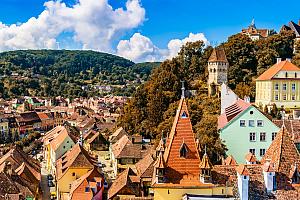Romania Photo of the Day by Dreamstime: Bran Castle in autumn colors

The Romania Photo of the Day created in partnership with stock photo provider Dreamstime aims to highlight the best of Romania. From stunning landscapes and popular tourist destinations and landmarks to people, traditions, and food, this series helps you discover Romania one photo at a time. This week, we put the focus on beautiful Romanian landscapes in autumn colors.
High above a small town near Brasov, silhouetted against the sky on an imposing mountain cliff, sits Bran Castle. (Photo source - click on the number to get to the photo 103767614 © Sorin Colac | Dreamstime.com)
The top of the cliff offers a great viewpoint, a feature to which travelmakertours.com attributes the very construction of a fortress here. They say the first fortress was built out of wood in 1211 by the Teutonic Knights, who had received the lands from King Andrew II of Hungary, in order to defend the Southeastern border of the Transylvanian region and the Hungarian empire.
From 1226 to 1377, the fortress was abandoned, and at the end of 1377, the Hungarian King Louis I of Anjou granted the people of Kronstadt the right to build a castle, so, according to rolandia.eu, the Saxons of Kronstadt built it at their own expense.
In 1388 Bran Castle was finished, and officially received the name it has today. It took on the role of military fortress, defending the border against the Ottoman Empire, and was used as a customs point and trade pass as well.
Between 1407-1419, Bran Castle was held by Mircea the Elder, the ruler of Walachia, given to him by Sigismund of Luxembourg as a place to retreat to during armed conflict with the Ottomans. And in 1441, Iancu of Hunedoara defeated the Turks here.
Despite popular belief, the reality is that Vlad the Impaler (Vlad Tepes) had little to do with the castle, although he passed through the area occasionally. During his first and second reigns, Vlad Tepes was allied with Bran, but at some point, he quarreled with the local Saxons, and in 1459 the voivode attacked Brasov, murdering hundreds of them.
From 1888 onwards, forest rangers and foresters lived in the castle, and it fell into disrepair. Then in 1920, Bran Castle became a residence of the royal family within the Kingdom of Romania, and as Queen Marie restored it and beautified it, it became one of her favorites. Later, during World War II, the castle was used as a hospital by Princess Ileana, Queen Marie's daughter, but in 1948 it was seized by the communist regime.
After many years, in 2009 the castle was given back to Princess Ileana’s legal heirs, namely Archduke Dominic, Archduchess Maria Magdalena, and Archduchess Elisabeth, who have since taken great care of the landmark.
Nowadays, it is a must-see for anyone visiting the country, as it is both beautiful and full of history - if not the history that has been popularized around the world.
The Dracula myth was in born in Communist Romania, as detailed in this National Geographic article: "In the 1960s, when Romania was ruled by a communist government, its tourism czars decided it could be advantageous to market a place associated with Vlad Tepes," says local historian Nicolae Pepene for the magazine. "They looked around at all of the available castles and decided that this castle at Bran, which guarded the one mountain pass running between Transylvania and Walachia, looked sufficiently Gothic."
For information on visiting Bran Castle, and everything one can see, do, and eat here, visit the official website.













